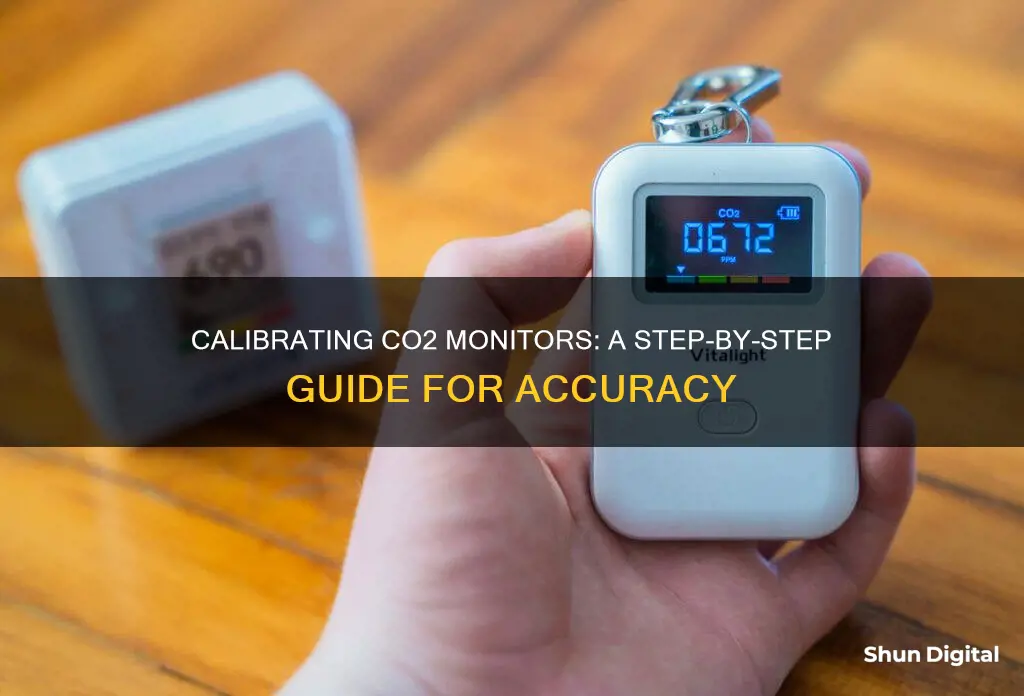
Calibration is necessary for all carbon dioxide sensors to maintain accuracy. There are various methods for calibrating a CO2 monitor, including using a known gas source or automatic baseline calibration (ABC). The former involves exposing the sensor to a known gas, typically 100% nitrogen, to duplicate factory conditions, while the latter is a self-calibrating method that uses indoor and outdoor air CO2 levels. Additionally, manual calibration can be performed through device settings, though this may result in spikes in the graphs.
| Characteristics | Values |
|---|---|
| Calibration frequency | 3-4 times a year |
| Calibration gases | Zero gas and calibration gas |
| Zero gas function | Sets the zero point of the CO2 meter |
| Calibration gas function | Matches the CO2 content in the working area of the meter |
| Calibration gas choice | Choose a calibration gas with roughly the same CO2 content as the working area of the meter |
| Calibration gas note | This can vary between seasons |
| Calibration steps | Connect the cylinder with the gas to the CO2 meter using a pressure regulator and open the feed |
| Stable measurement time | 1 minute |
| Manual calibration | Can be launched from the application settings |
| Manual calibration duration | 6 hours |
| Manual calibration accuracy | May see spikes in the graphs due to fewer measurement points |
| Automatic calibration accuracy | ± 100ppm to 1000ppm and ± 10% for measurements greater than 1000ppm |
| Calibration methods | Known gas, automatic baseline calibration (ABC), fresh air |
What You'll Learn

Calibration using nitrogen
To perform calibration using nitrogen, you will need a tank of pure nitrogen, calibration software, and a sealed calibration enclosure to ensure the accuracy of the process. The sensor is connected to the nitrogen tank using a pressure regulator, and the feed is opened for about a minute until a stable measurement is achieved. The sensor should indicate a concentration of 0 ppm CO2; if it does not, you may need to manually set it to 0 ppm. This step sets the zero point of the CO2 monitor.
Nitrogen calibration is generally more expensive than other methods due to the equipment required. However, it offers a more precise calibration than methods such as fresh air calibration, which may not guarantee maximum accuracy.
It is important to note that while nitrogen calibration provides an accurate zero point for the sensor, it does not constitute a complete factory calibration. For a full calibration, a two-point or span calibration is required, which involves exposing the sensor to both the lowest and highest gas levels for which it is rated.
ASUS 144Hz Monitors: Best Gaming Displays for Competitive Players
You may want to see also

Calibration using fresh air
Fresh air calibration is best for sensors in manufacturing settings or greenhouses, where the sensor is constantly exposed to different CO2 levels. It is also useful for portable, handheld devices that can be easily taken outdoors.
The main advantage of this method is its low cost, as it does not require a tank of pure nitrogen or calibration software. However, it is less accurate than calibration using nitrogen.
Monitor MLs: How to Measure and Identify Your Screen Size
You may want to see also

Zero point calibration
The advantage of calibrating a CO2 sensor with 100% nitrogen is that it removes any deviation from the sensor's zero point (0% CO2) as it ages. However, the disadvantage is that resetting the zero point is not the same as a complete factory calibration. For a complete factory calibration, a 2-point or span calibration is required.
The frequency of zero point calibration depends on the operating environment. In a challenging environment, more frequent adjustments may be required. For specific industries, the following calibration cycles are recommended:
- Scientific Experimentation – zero calibration before each test
- Safety – zero calibration at least annually
- Beverage/Restaurant – zero with nitrogen at least annually
- Indoor Greenhouse – zero with nitrogen after each growing cycle
- Manufacturing – zero with nitrogen at least annually
- Indoor Air Quality – zero with nitrogen annually, or ABC or fresh air as desired
Asus Portable Monitors: Compatible Partners for MacBook Pro 13?
You may want to see also

Span calibration
- Expose the sensor to a pure inert gas, such as nitrogen or argon.
- Record the sensor's reading for 0% of the target gas in the sensor's memory. For example, in the case of a CO2 sensor, the reading for 0 ppm CO2 is recorded.
- Next, expose the sensor to a known percentage of the target gas. This is often the highest level for which the sensor is rated. For instance, if the sensor is rated for 5% of the target gas, expose it to that concentration.
- Record the sensor's response to the second known gas in its memory.
- Once these two points are known, you can assume a linear response to the gas concentration between them. This is known as a calibration curve.
- Perform a calculation based on the calibration curve so that a concentration can be computed for every gas level. This calculation can be a simple slope intercept for a straight line or, in the case of a curve, a slope of a curve formula called the derivative.
- During span calibration, store a second value called the zero-point adjustment in the sensor's memory. This is the value the sensor reads when exposed to the zero calibration gas.
- The difference between the zero-point adjustment and the actual reading when exposed to 0% gas is saved as an offset, which is applied to future readings.
Monitors: Worth the Investment for Your Setup?
You may want to see also

Automatic calibration
Automatic Baseline Calibration (ABC) is a method developed by SenseAir in Sweden, which uses the theory that in a room that is unoccupied for a period of time, the CO2 level will return to the same level as outdoor air (around 400 ppm). The sensor stores the lowest CO2 readings over time in its memory and calculates an offset to 400 ppm, which is then added or subtracted from the actual CO2 readings. This method is self-calibrating and works over the life of the sensor.
However, it is important to note that ABC calibration has its limitations. It may not work properly if the sensor never "reads" 400 ppm fresh air. For example, it would not be suitable for an indoor livestock environment or an office that is staffed 24/7. Therefore, it is best suited for situations where fresh air CO2 levels can be recorded by the sensor every few days.
Additionally, some CO2 sensors are calibrated automatically by the manufacturer during the production process. These automatic calibrations are typically performed weekly to better adapt to the surrounding environment. However, they may need to be restarted if the power source is interrupted.
It is worth noting that while automatic calibration is convenient, it may not always provide the highest level of accuracy. For applications requiring maximum accuracy, such as scientific experimentation or personal safety, manual calibration methods using known gases or fresh air may be more suitable.
Hooking Up Multiple Monitors: USB Desktop Connection Guide
You may want to see also







